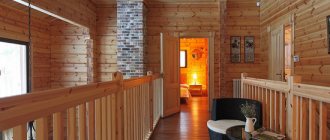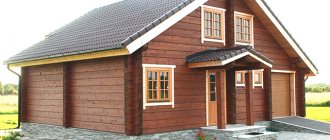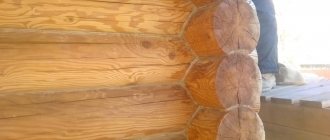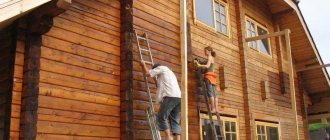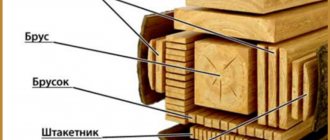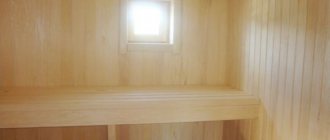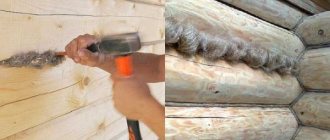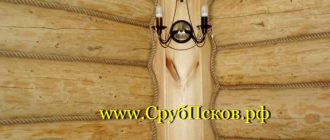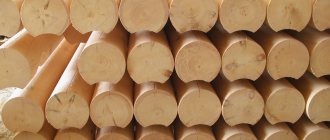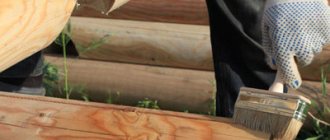In wooden house construction, jute rope has often become used for finishing the logs of private houses, cottages, and bathhouses made of timber or logs. The material is excellent for interior and exterior decoration of structures. From the article you will learn the features of insulating wooden houses with jute rope, the nuances of choosing a size, and methods of fastening. Jute rope has gained wide popularity due to its unique physical and decorative properties. Such insulation effectively protects the room from blowing, atmospheric influences, and emphasizes the natural beauty of wood. Moss, tow, and jute fiber are traditionally used as insulation. In combination with a rope, an excellent result is obtained.
Rope is used to fill horizontal and vertical joints of logs, upper and lower baseboards. Also, jute rope is used to wrap pillars, columns, and decorate beams, fences, stairs, window and doorways.
What is jute rope and what does it consist of?
Plant fibers are used to produce rope material. From the yarn (bobbins) obtained after processing the plants, ropes are obtained that are twisted together. Jute rope for finishing a log house has universal properties, which is why it has gained wide popularity in wooden house construction. This type of finishing is relatively inexpensive.
Initially, the cord was used exclusively to protect the seams between the crowns, but over time it began to be successfully used for decorative purposes. Today, a better material for external insulation and beautiful finishing cannot be found. You will learn how to choose a rope from natural material and attach it to a log house in this article.
Features and advantages of the material
Jute rope is made from environmentally friendly raw materials - fibers of the jute bush of the Malvaceae family. The plant grows in India, Bangladesh, Pakistan, Australia, and Africa. After assembly, the stems are soaked and dried for 3-4 days in the open air. Next, the raw materials are sent to the factory. As a result of processing, thin, strong threads are obtained that are twisted together. The rope is made from twine using the torso lay method. Ropes made from natural and synthetic threads are also used for finishing wooden buildings, but jute wicker products have a number of advantages. Due to their natural origin, jute fibers are safe for health and the environment. It is important that the composition does not contain felt or batting; they reduce the performance properties of the product.
Jute fibers contain natural resin (lignin), making the products resistant to rotting. This substance also increases the density and strength of fibers, resistance to tearing, and is an additional binding element. The ropes do not fray, do not thin over time, and retain their original shape and presentable appearance for a long time. Due to its high heat capacity, jute fiber is often used as inter-crown insulation. The material withstands atmospheric influences: humidity, ultraviolet radiation, temperature fluctuations. Jute fibers do not electrify, do not emit toxic substances, are hypoallergenic, and have bactericidal properties. The product does not require additional treatment with antiseptic or varnish compounds. Another important advantage of the product is its affordable price.
Selection of jute rope
The market sells a cord with a diameter of 4-33 mm. But from an aesthetic point of view, a thin rope does not create the desired effect, and too thick a rope looks rude and spoils the appearance of the building. Therefore, it is best to finish the seams with jute rope of medium thickness. For wall insulation, a rope with a thickness of 10 to 22 mm is better suited, which covers the roof joint well. When choosing a decorative element, you need to pay attention to the diameter of the log. For small logs, a thin cord is better.
To decorate a log house, you can use different types of cords, but the traditional jute version is the most affordable and relevant. The natural material is made from a tropical plant that grows on plantations flooded with water. Since ancient times, people have woven ropes from it, which were highly durable and did not collapse under the influence of moisture and sunlight for many years.
Rope compactor is sold in large coils of 240 and 250 meters. The length in the coil depends on the thickness of the rope; the thicker it is, the fewer meters, which should be taken into account when calculating. But sometimes the manufacturer offers rope products on special plastic spools, in film packaging (10 and 15 meter lengths).
Today, sealing seams with jute rope in a log house is not only profitable, but also fashionable. The natural material matches the color of the log perfectly, therefore it is used as a decorative finish for the following elements of a wooden frame:
- skirting boards (upper and lower);
- interventional joints;
- pillars and columns.
This is an indispensable material for sealing the vertical corners of the logs, because it is in this part of the log house that no other finishing material is suitable. It is easy to attach. Numerous photos clearly show how beautiful and neat the seam made from jute rope is.
Why decorate the walls of a wooden building with rope?
To finish a wooden house from the outside, clapboard or siding, brick, imitation timber or block house are used. But a log house is often chosen precisely because it looks great in its natural form, without additional finishing. Experts advise painting the walls of the log house with paint or tinting impregnation (it will preserve the beauty of the wooden building), but one aesthetic drawback will certainly remain - unsightly gaps of different thicknesses between the logs of the log house.
To preserve the original woody appearance of a log house and properly disguise the seams, you can use rope. A rope of a certain thickness is twisted from natural fibers. Sold in a package in the form of a coil, from which it must be unwound during the fastening process. You can attach it using special nails or glue (heat gun). Jute rope is required not only for aesthetics but also for practical purposes.
1.1. Technical tasks
Large gaps are exposed to the elements, so rounded log buildings need to be properly protected. For this purpose, not only a sealant is used, but also special decorative ropes. You can buy a reel of any size inexpensively in numerous hypermarkets - the affordable cost is one of the advantages of this material. The fastening is applied in one layer.
The external joint requires sufficient attention. Quite often the first row of weatherstripping in an older building will need to be refinished. The quality of exterior finishing affects the comfort of living in such a house.
An important property of finishing is additional insulation, sound insulation and protection of a wooden house from drafts. Thanks to the dense rope, which is placed in the seams of the log house, the wooden house is not blown through and retains heat longer, and the owner saves on heating.
With this protection, dust and moisture do not get into the seams. The liquid, going through a cycle of freezing and thawing, due to constant humidity, completely destroys the tree. And the natural structure of the jute fibers of the rope absorbs water well, but does not release it.
This is interesting.
The rope is made from flax and hemp processing waste, and accordingly, it is characterized by the quality of natural raw materials.
It is inexpensive, so in Russia it has gained wide popularity in the exterior and interior decoration of wooden houses. Decorative cords made from raw materials of natural origin are successfully used to achieve an antique effect when building a new home. It is worth considering that if tow or other soft insulation sticks out even slightly from the joints between logs, birds are hunting for it. Birds steal such finishing materials to build nests. The rope will block their access - this is another useful property.
1.2. Decor of a log house from the inside with rope
Protruding inter-crown insulation is simply ugly. Even if, after assembling a house from a log, the material is compacted very tightly into the seams, it will be visible due to the uneven edges of the logs. The photo shows that a rope of medium thickness allows you to hide a narrow section, but leave the noble texture of the wooden building visible.
Natural jute rope is highly popular in wooden low-rise housing construction. Increasingly, people are using natural materials, including jute cord, for the construction and decoration of houses. They help to create a solid, but not pretentious style and give the house a cozy old-fashioned flavor. Jute rope is also used for finishing and decorating the inside of a log house.
For external and internal decorative finishing, it is recommended to use approximately the same materials. This will help you find and maintain the style of a wooden building. This material is used for any buildings assembled from logs:
- house;
- country house;
- bath;
- cottage;
- summer cuisine;
- economic block.
A cable with a small diameter is not only laid in the seams between the crowns of the log house, but also installed instead of baseboards indoors. It is also convenient for them to design crosshair corners. It is difficult to install anything to these places, but the flexible weaving tightly hugs the logs, and the result is very neat seams (see photo)
Does jute rope need to be treated and with what?
Treatment of the cord with antibacterial and water-repellent agents is provided only for outdoor work. This procedure is carried out for the sole purpose of extending the service life of the insulating material. But what is the best way to process jute rope? The most commonly used is linseed oil. But a good result is obtained with the help of a special impregnation Neomid Biocolor Ultra. This product not only protects the seal from adverse environmental influences, but also improves its decorative properties.
Types of finishing
The rope is secured in different ways. The most convenient of them is installation at the joint using hot-melt adhesive, as well as galvanized finishing nails. First, the adhesive is applied to the joint using a special gun for extrusion, and then proceed to fastening with nails. They are hammered into the lower and upper logs in increments of 10-20 cm. Where the communication wires pass, the nails are replaced with staples. When laying a rope, it must always be in a taut position.
How much does the cord cost?
Before you buy jute insulation for a log house, you need to find out the price. The table shows the cost in different cities of Russia. Therefore, anyone interested in this question can roughly calculate how much rope finishing of a log house will cost
| Cities | The cost of jute cord with a thickness of 8-22 mm is rubles per 1 linear line. meter |
| Moscow and Moscow region | from 5.90 to 64.80 |
| Saint Petersburg | from 5.90 to 64.80 |
| Ufa | from 6.70 to 65.60 |
| Novosibirsk | from 6.70 to 65.60 |
| Chelyabinsk | from 6.70 to 65.60 |
The larger the diameter of the jute rope, the higher the cost per 1 linear line. meter. In all regions of Russia the price is approximately the same.
Due to the fact that the construction of wooden houses is in demand, the demand for rope products is also growing. Natural sealant is inexpensive, and in wooden house construction it plays a significant role: it insulates and decorates the facade/interior of the building.
Source of the article: https://infobrus.ru/otdelka/dzhutovyj-kanat-dlya-otdelki-sruba.html
Why do you need caulking for a log house?
Wooden houses have always been popular. Both residential buildings and country houses were made of wood. This is due to the fact that the tree is an ecological plant. Therefore, wooden material is of high quality in construction and can be used for a long time. It has high sound insulation and thermal conductivity.
Photo: caulking of the log house on the outside with jute inter-crown tape.
It is very important to correctly assemble the logs of the log house, dry them completely, shrink them and caulk them. The latter activity is of great importance. So, when choosing jute for caulking, you need to take into account the nuances and order of placement of jute - jute tow (tape). During the drying of the logs, the tree shrinks. Gaps appear between them. In order to fill them you need jute and other types of insulation such as tow. Jute insulation performs two functions:
- fills the gaps that appear, thus. wind protection appears;
- Provides thermal insulation and retains warm air indoors.
Finishing with jute rope and methods of attachment to the frame
One of the stages of insulating a wooden house or bathhouse is laying jute rope.
Fastening jute rope inside the house transforms the building and adds color to the room.
Fastening jute rope during external work allows you to hide the seams with inter-crown insulation , which prevents birds from pulling it out, and also provides additional insulation for a wooden house.
Thus, jute rope in wooden house construction is necessary for both decorative and protective purposes.
IMPORTANT! The jute rope is attached no earlier than six months after the completion of the assembly of the wooden house, in order to avoid weakening (deformation) of the fastenings after the house settles.
Features of fastening the steel cable to the drum
The process of attaching the rope to the drum is characterized by the greatest number of distinctive features.
These rotary-type mechanisms are used in all kinds of winches and other structures. Mechanisms are also often used to lift various loads. To reliably connect the rope to the drum, two main methods are used:
- Wedges that fit into slots in the drum.
- Pressure strips.
Both approaches provide high-quality connections and prevent cables and jute ropes from slipping when wound around the structure.
The first type of connection implies that a blade of a certain thickness is placed in a loop and then fixed in a socket. The second example shows that the strips for pressing wicker products can be located both on the end part of the flange and on the working surface of the drum. In both cases, a rigid connection of the cable ends is guaranteed.
Options for fastening jute rope
To fasten jute rope of small diameters for decorative purposes, it is more effective to use the method of fastening the rope using semicircular staples. These staples are similar to staples for a construction stapler.
Larger jute rope is secured with special “finishing” nails. When fastening in this way, the main condition is that the rope completely covers the inter-crown insulation. Jute rope is placed between the logs and nailed crosswise to the surface using a hammer. The pitch between nails is 15-30 cm.
Another common option for fastening a jute rope is punching it with nails. This must be done often so that the rope is stretched tightly. Don't worry about the nail heads - they will hide in the rope. In a similar way, you can fasten with self-tapping screws using a screwdriver.
“Creative” methods of attaching a jute rope include installing the rope using various sealants or glue. We do not recommend this option due to the impossibility of ensuring the quality of fastening in this case.
For INFO! Most often, ropes with a diameter of 13,14,16,19 or 22 mm are used for inter-crown fastening. The smaller the diameter of the log, the smaller the diameter of the jute rope. For example, 16 mm jute rope is suitable for a log house D = 260-280 mm.
How to buy:
- You can place an order by calling us by phone +7 (351) 237-26-98
- You can place an order on the website
- You can place an order by writing an email to [email protected]
Russia, 454091, Chelyabinsk, st. Ordzhonikidze, 43, office 207 Personal data processing policy
Source of the article: https://kanatchel.ru/articles/otdelka-dzhutovym-kanatom-i-sposoby-kreplenija-k-srubu/
Types of fasteners and their designs
Jute products can be connected both temporarily and for a long period. In both cases, different fastenings of the rope ends are used. The operating principle of these devices is extremely simple. The main task of the mechanism is to prevent the possibility of cable slipping.
Clamps
This option is the most common and easiest to install. Such clamps consist mainly of two elements - pressing and adjustable.
U-clamp
Perhaps the simplest type of connection. To implement, you will need a U-shaped bracket and a special strip. Such fastenings are used even on heavy-duty cranes. The tightening is adjusted by nuts that are screwed onto the edges of the bracket. The undeniable advantage of this mechanism is the strength and durability of the connection.
Flat cable clamp
To install this sample, you will need a pair of plates. The parts are designed to compress the two sides of the rope, preventing it from slipping under serious load. Direct fixation is carried out in many cases with bolts. The clamp nuts tighten the cable, which remains motionless even under critical overloads. The clamping bars may have a corrugated surface on one side.
Options for fastening jute rope
The work of sealing inter-crown joints does not require special knowledge; it can be done without the help of specialists. However, it is important to know how to properly attach jute rope. Professionals usually use the following methods:
- Using nails. The material is applied to the joint and secured to the logs with galvanized nails. Drive two nails side by side, not directly, but diagonally towards each other, so that the heads go deep into the jute. The rope should completely hide the caulked seams. The maximum distance between two adjacent nails is 1.5-3 cm. You should not take more steps, since over time the rope can sag and form cold bridges.
- Using a glue gun. This is the easiest and fastest option for attaching a jute rope. To work, you need a heat gun and adhesive nails. Glue is applied to the joint and a rope is applied to it. It is important to press the material firmly against the wood so that it sticks well. The advantages of this method are that hot melt adhesive not only serves as a fastener, but also prevents the penetration of wind and moisture.
Let's use hot glue
Sealing cracks using glue and nails is a fairly reliable, but labor-intensive process. Hot melt adhesive will help make it easier. It is produced in the form of rods, which are tucked into a special “gun”. Before starting work, the heat gun is first warmed up. Then the rod is inserted into it. Under the influence of temperature, it melts and takes on a liquid form.
In this form, it is applied to logs in the form of drops. In this case, the glue should get on the lower log closer to the crack . After applying the rope, it is distributed to the lower log. Since the glue hardens quickly, you need to act quickly and carefully. Treat a small area at a time. After applying the rope, wait a few seconds and move on. How the log house will be finished with rope depends on its owner. The same can be said about the choice of material for this.
How to choose a rope?
When choosing a jute rope for sealing intervention seams, you must follow the following rules:
- The rope must have high density and rigidity, then even after several years it will retain its properties and attractive appearance.
- You need a rope of the correct diameter. For wide logs you should choose a thick rope; for timber with a smaller diameter, a thin rope is suitable.
Source of the article: https://kanatmarket.ru/stati/kak-krepit-dzhutovyj-kanat-k-derevyannomu-srubu
Caulking mistakes
- You cannot use jute derivatives - felt, linen, etc. Each of them has rigidity, and when the temperature changes, they are capable of breaking.
- You cannot do the process of assembling the log house right away. Thus, the entire decoration will become unusable - during shrinkage, the material will squeeze out, it will hang sloppily and deteriorate under external weather conditions. What a savings there really is.
- Use PVA glue to hold the decorative material on the surface of the frame as best as possible. This is no good - the glue will darken and crack. The appearance will be ruined. It is better to do the punching more carefully, then both the grip and beauty will remain worthy.
- Hammering the rope almost completely is an inappropriate expense. Yes, and you can expose the crowns to an unstable position, because the rope is a fairly thick and rigid material and can lift the crowns, which is not good. Although in this way, some venerable carpenters straighten the frame as a whole. If the owners are not like that, it’s not worth the risk. It would be ideal if half of the rope is under the log.
What you read can be a good help for the home master in the upcoming process.
